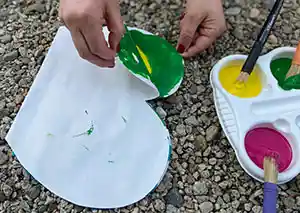Butterfly Symmetry Painting

Create beautiful butterflies and learn about symmetry at the same time!
Create beautiful butterflies and learn about symmetry at the same time!
Ready, Set, Create!
![]() Caregivers or children should fold a piece of paper in half. For younger children, it may be helpful to draw a line on the crease so they can see it more easily. Caregivers or older children can cut the paper into the shape of a butterfly before painting, or they can do this once the paint has dried at the end of the process.
Caregivers or children should fold a piece of paper in half. For younger children, it may be helpful to draw a line on the crease so they can see it more easily. Caregivers or older children can cut the paper into the shape of a butterfly before painting, or they can do this once the paint has dried at the end of the process.

![]() Pour paint into shallow dishes and put the dishes out on your work surface, along with paint brushes.
Pour paint into shallow dishes and put the dishes out on your work surface, along with paint brushes.
![]() Show children how to paint only on one side of the paper, using the crease or line as a guideline for where to keep the paint. Children should be sure to use enough paint so the colors mix and a beautiful design can be made. If too little paint is used the effect will not be as dramatic.
Show children how to paint only on one side of the paper, using the crease or line as a guideline for where to keep the paint. Children should be sure to use enough paint so the colors mix and a beautiful design can be made. If too little paint is used the effect will not be as dramatic.

![]() When children have finished painting, help them to fold the paper in half and show them how to press down on the painted paper. Be sure to use your hand to rub the paper all over, so the paint spreads evenly.
When children have finished painting, help them to fold the paper in half and show them how to press down on the painted paper. Be sure to use your hand to rub the paper all over, so the paint spreads evenly.

![]() Next peel the painted paper apart to reveal the symmetrical butterfly paintings.
Next peel the painted paper apart to reveal the symmetrical butterfly paintings.


![]() Display these beautiful and colorful butterflies once your paint has dried!
Display these beautiful and colorful butterflies once your paint has dried!

Engage Children in Conversation
Comment on what you observe, such as I notice you used two colors of paint” or “What do you think will happen when we fold the paper together?”
Ask children open ended questions that encourage critical thinking, such as:
What happens when you mix these two colors together? Will your colors mix? Why or why not?
For very young children, try asking “either/or” questions, such as;
Are you using the red or blue paint?
Did you paint three dots of paint or two?
Extensions
Caregivers can place real-life photographs of butterflies around the work space for inspiration. They can explain what “symmetrical” means and look at photos of butterfly wings to notice the symmetrical designs.Brainstorm other things that have symmetry.
This project can also lead to conversations about color mixing, since the paint will mix together when the paper is folded in half.
Modifications
![]() Caregivers can gauge which parts of this project will be able to be done independently by children and which parts will benefit from assistance. For example, some children may be able to cut paper in the shape of wings, while others may need an adult’s help.
Caregivers can gauge which parts of this project will be able to be done independently by children and which parts will benefit from assistance. For example, some children may be able to cut paper in the shape of wings, while others may need an adult’s help.
![]() Caregivers can help guide children by drawing a line down the middle crease of the paper to give a visual cue of where painting can occur.
Caregivers can help guide children by drawing a line down the middle crease of the paper to give a visual cue of where painting can occur.
![]() Paintbrushes of different sizes may be used for different children, depending on their fine motor strength and abilities.
Paintbrushes of different sizes may be used for different children, depending on their fine motor strength and abilities.
